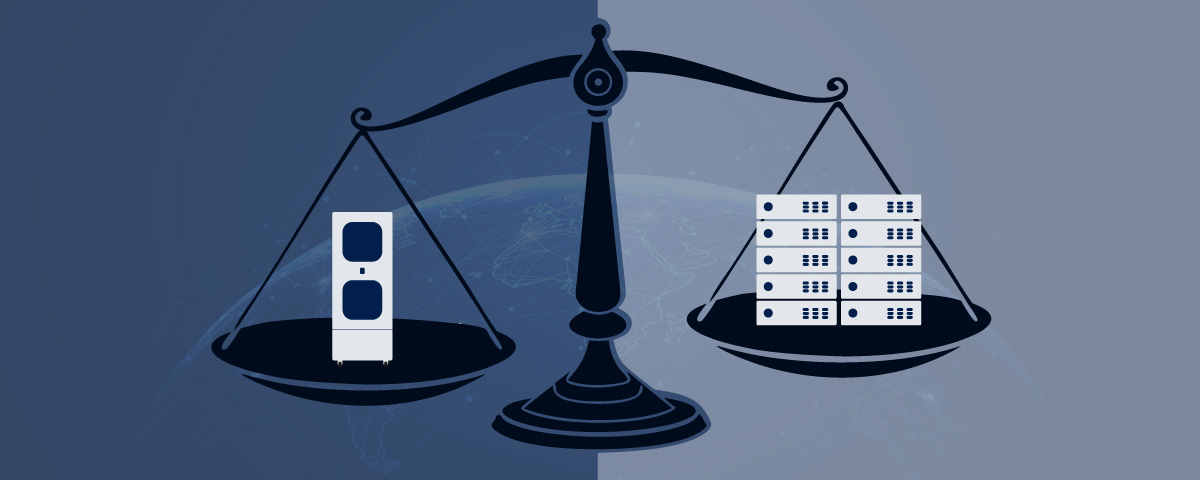The definition of a data centre
A data centre is a physical location used to house computer systems and related components, such as telecommunications and storage systems. It includes backup power supplies, redundant data communications connections, in-room environment control (e.g., air conditioning, fire suppression) and security. In today’s energy-aware climate, it’s worth noting that the largest data centres are industrial-scale operations, consuming as much electricity as a small town.
The birth of the data centre
Large scale computer rooms began to appear in the 1950s. These early systems had huge, complex hardware challenges and needed a cold, dry and secure operating environment. The multiple interconnecting devices and extensive cabling required elevated floors and many precious square metres of prime real estate to house these rooms. In addition, the operation of a single mainframe computer used colossal amounts of power and cooling to prevent overheating. This made the construction of a data centre a complex and expensive affair.
Secure access was also very important – mainframes were expensive and were often used for military purposes.
Fast forward to the 1980s and computers became commonplace. Little concern was afforded to operational requirements and PCs began to appear in the old computer rooms. These were called servers, and inexpensive networking equipment meant that companies could house them in a specific room within premises. As information technology (IT) operations became more complex, companies started to pay increasing attention to the control and management of their IT systems.
The path to efficiency
The dot-com bubble of the 80s and 90s saw the popularity of data centres increase exponentially. Companies needed fast Internet connectivity and non-stop IT operations to establish their internet presence. Today, with the increase in uptake of cloud computing, businesses are turning their attention to the areas of security, availability, environmental impact, portability, accessibility, resilience and adherence to standards.
Much has changed since the old mainframes of the 50s and 60s. Back then, computers, tapes and disk drives filled entire rooms. Highly skilled and expensive engineers were needed to schedule jobs, load tapes, switch disk packs and ensure that the data centre environment remained cool and secure. The setup and maintenance costs of data centre rooms were extremely high, requiring specialized skills to build, manage and support the location in which large mainframe computers were housed.
Fun fact: the same base blueprint is still used for modern data centre layout, from the even spread of hardware, hot/cold aisle design and carefully controlled and cooled environments.
It was not long until realisation dawned that hardware acquisition costs were not worth their price when paired with the spiralling expenditure of long term running costs. Conventional wisdom is changing as customers seek ways to reduce these overheads. While processing and storage solutions are shrinking in size and growing in capacity, the prevailing design continues to dedicate an expansive area of corporate space to the traditional data centre. This area is secured with electronic locks and cooled with roof-mounted chillers pumping air through a raised floor, with the hope that the space is never outgrown or originally overestimated.
The containerised data centre
The industrialisation of the data centre has given birth to a variety of modular development methods by companies seeking to significantly reduce the costs of building, management and maintenance. The concept of modular data centres was born from the need to:
- Decrease the costs of building data centre rooms
- Decrease power consumption costs related to refrigeration
- Increase security, access and protection of the servers
- Decrease the costs of operations and ongoing maintenance
- Increase mobility so that data centres can be moved if necessary
- Increase resilience, allowing data centres to be moved from a natural disaster area
The development of the containerised data centre was ground-breaking, creating a significant shift in the marketing strategies that encouraged greater consumer involvement.
Whilst moving a containerised solution is not as simple as jumping in a car and driving it away, it does allow for mobility. In a traditional facility, it is virtually impossible to relocate without months, if not years, of planning. Conversely, a containerised data centre incorporates the entire infrastructure needed to support power and cooling needs, as well as the racks of IT equipment.
Containerised data centres give way to modularity
The phrase, modular data centre, implies a pre-fabricated data centre module or the ability to deploy data centre infrastructure in a modular and flexible way. A containerised option is based on building a bespoke solution that’s pre-built and delivered in its entirety. On the other hand, a modular data centre defines the installation and deployment methodology of constructing it from a set of modular components. This delivers the speed of setup and scalability when/if needed. It’s possible to combine the two, with a containerised data centre being built using a modular format.
Introducing the micro data centre
The natural evolution of data storage is for a portable, scalable, customisable, self-contained solution that’s both easy to self-manage and cost-effective. Enter the micro data centre (MDC).
An MDC is a portable modular unit that affords the data storage and networking ability necessary to function at a local level. It’s self-contained, combining the power, cooling and other infrastructure required to securely store data without the need to construct expensive computer rooms or send information to be stored in the cloud.
MDCs are small – typically the size of a refrigerator – and are scalable, allowing for an increase in storage as requirements grow. They represent significant reductions in operational costs (no more expensive technical staff to an on-premises server room) and power consumption. Moreover, it allows for portability (it can be moved around to where it is needed or away from natural disaster zones, such as hurricanes). It can be offered as a single, turnkey solution or as a set of modular data centres, depending on customer needs.
MDCs are the perfect solution for companies that need to retain a critical infrastructure either in-house or in infrastructure-poor remote locations, without having to foot the bill to build a traditional data centre. They also include integrated remote management, monitoring and security, with the ability to change/remove data centre access to specific individuals, as well as being able to remotely control environmental needs.
What is an Edge Micro Data Centre?
Edge computing is the term used for data analysis and storage that happens as close as possible to where the data is produced – quite literally, at ‘the edge’. An edge MDC is a small-sized, self-contained modular unit in such a location. An example would be – one MDC installed close to a smart traffic junction that needs to respond to ever-changing conditions in order to operate traffic lights and other facilities, allowing the free flow of vehicles.
The edge encompasses a variety of regions. These are:
- The inner edge: the closest data analysis and storage to the action
- The outer edge: larger data centres that ingest the information fed from the inner core
- The regional edge: the third stage of the network that’s fed the necessary information as it moves through the chain. From here, any data needed to be stored and/or analysed further can be transferred onto a hyperscale data centre (a location not on the edge and that houses millions of servers).
Edge MDCs are ideally suited to be utilised at the inner edge.
What are micro data centres used for?
In addition to the edge computing facility, MDCs are used in situations where the construction of an onsite data storage centre or the transference of realms of data to cloud storage aren’t appropriate.
The portability and ease of use within infrastructure-poor locations have been embraced by a variety of industries. Mining is one such example, where hostile, remote environments require innovative solutions for secure, dependable data storage with remote maintenance ability. They’re also ideal for small and medium enterprises (SMEs), who’re looking for a data storage solution that’s affordable, secure, and can be expanded as required.
What are the benefits of micro data centres?
MDCs offer multiple benefits, both to large-scale organisations looking to optimise edge computing and SMEs seeking a storage solution to be housed on-site.
The key benefits can be summarised as follows:
- Quick to deploy, typically taking one week
- Simple to maintain, needing no specialist knowledge to do so
- Physically and digitally secure
- Multiple models available, allowing them to be sited both internally and externally as per requirements
- Offers dramatically reduced running costs over traditional on-site data centres
- Simple to add storage capacity without the costs associated with a traditional on-site server room
- Can standardise IT operations, increasing efficiency and allowing in-house control over compliance needs
- Mobile, allowing for simple storage movement should you need to change premises
- Provides data centre capability with the smallest of footprints
- Environmentally sound, helping companies reach their environmental responsibilities thanks to reducing carbon emissions.
What applications and industries are set to benefit from micro data centres?
Virtually every industry is set to benefit from MDC technology. Alongside mining, other industries ready to gain an advantage include:
- Farming: Smart farming needs definitive edge computing availability. MDCs allow for portable, fast deployment in both indoor and outdoor locations
- Telecoms: As 5G becomes a reality, the supporting technology will need to be upgraded to enable full functionality
Security & surveillance: Systems that keep premises and people secure need latency-free data analysis to react at the exact moment an incident occurs - Healthcare: As smart healthcare devices are rolled out, the immediate analysis of data produced will become even more vital. Examples include remote cardiac monitoring that needs instant action for the health of the individual involved
- Manufacturing: The industry relies ever more heavily on smart manufacturing elements. Data analysis and storage on-site will, therefore,
become increasingly more necessary. - Transport: Logistical efforts can be simplified with actionable real-time data
- Education: Schools and universities can benefit from the ease and value offered by micro data centre storage
- Defence: MDCs reduce the need for critical data transfer outside of an organisation’s control
- Retail: The technology allows even the smallest of concerns to create and analyse data into customer behaviours and stock control that can streamline costs, operations and increase buying habits.
In short, while micro data centres are poised to revolutionise the concept of data storage, they’ll do so in a manner that complements existing solutions, rather than replacing them. With the advent of edge computing, the ease of micro data centre placement is set to become an integral element of a wider storage network that allows for a web of interconnected devices.
In addition to advantages afforded to SMEs and larger concerns through local storage solutions, this revolution places us on the brink of change to the traditional methods we’ve become accustomed to.
Get in touch to find out more about our products.





